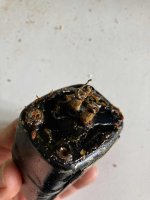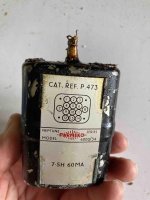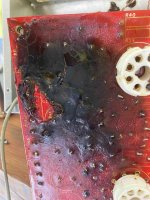Hi all.
One of my first ever valve projects was a pcb-based PP EL34 with a whole bunch of salvaged transformers. For years, I used an underspecc'd pair of power supply chokes. One day, after maybe a decade of heaps of use, one of them sprang a leak and coated everything in thick oily waxy substance.
1) any thoughts about if this is toxic or if it is just mineral oil?
2) any concerns about just washing it off, replacing the chokes with something more appropriate, and then putting her back into service?
Many thanks!!
One of my first ever valve projects was a pcb-based PP EL34 with a whole bunch of salvaged transformers. For years, I used an underspecc'd pair of power supply chokes. One day, after maybe a decade of heaps of use, one of them sprang a leak and coated everything in thick oily waxy substance.
1) any thoughts about if this is toxic or if it is just mineral oil?
2) any concerns about just washing it off, replacing the chokes with something more appropriate, and then putting her back into service?
Many thanks!!
Attachments
I've not been able to confirm if the oil contains PCB in that vintage english type product - perhaps best (in hindsight) to treat it as if it does. Similar issue with encapsulated can caps from that era. Afaik, only Australia provided a definitive listing of caps that used PCB (or not).
Oil is oil, that looks like some type of potting compound. I've seen plenty of oil capacitors but not many oil filled chokes or transformers.
Thanks both.
So I take it that I probably should be a bit cautious in how I dispose of it but it probably isn't a serious health hazard to me and others in my house.
So I take it that I probably should be a bit cautious in how I dispose of it but it probably isn't a serious health hazard to me and others in my house.
Well, I have heard of people salvaging PCB from old transformers and using it as cooking oil.. but it's a known carcinogen nonetheless.Oil is oil,
If the components on the board can handle strong solvents, you could try cleaning it with acetone. Do so outside as acetone evaporates pretty quickly and isn't good to breathe.
After the acetone, rinse with isopropyl alcohol to remove the acetone and then distilled (or deionized) water to remove the alcohol and whatever else. Then shake the water off. Blow any excess water out of the tube sockets and other nooks and crannies with a can of compressed air. Then let the board dry. If it was a clean board, I'd suggest putting it in the oven for 15 minutes at the lowest temperature the oven can be set at (mine goes down to 65 ºC). But with the PCB and solvents it's probably best to just let it air dry for a few days in a warm spot.
Note that acetone eats many plastics, including polystyrene. It's commonly found in flux cleaner and is safe for most modern parts. You can usually find acetone in the paint department of your local home improvement store.
Tom
After the acetone, rinse with isopropyl alcohol to remove the acetone and then distilled (or deionized) water to remove the alcohol and whatever else. Then shake the water off. Blow any excess water out of the tube sockets and other nooks and crannies with a can of compressed air. Then let the board dry. If it was a clean board, I'd suggest putting it in the oven for 15 minutes at the lowest temperature the oven can be set at (mine goes down to 65 ºC). But with the PCB and solvents it's probably best to just let it air dry for a few days in a warm spot.
Note that acetone eats many plastics, including polystyrene. It's commonly found in flux cleaner and is safe for most modern parts. You can usually find acetone in the paint department of your local home improvement store.
Tom
Thanks.
I used straight isopropyl alcohol and a stiff plastic brush and got it pretty clean, at least to the point that I'm happy to go forward. I rinsed it and have it in a dehumidifying room, so maybe it'll make it through!
I learned my lesson and am upping the power handling to a 450mA pair..
I used straight isopropyl alcohol and a stiff plastic brush and got it pretty clean, at least to the point that I'm happy to go forward. I rinsed it and have it in a dehumidifying room, so maybe it'll make it through!
I learned my lesson and am upping the power handling to a 450mA pair..
It is worth being aware that vintage parts did contain PCB material.
A good summary is in this link - which also has a simple density test.
[PDF] User Guide Environmentally Sound Management of PCB - Free Download PDF
Another good summary is in the next link, and that includes a link to known parts (the vast majority are capacitors, especially the canned type that often had trade name identification like Duconal).
https://environment.des.qld.gov.au/__data/assets/pdf_file/0035/88982/pr-gl-managing-pcb-equipment.pdf
Oil fortified with PCB was more expensive than insulating mineral oil, so hopefully that cheaper style of commercial transformer just contains mineral oil. PCB fortified oil was also supposedly gel like, and there is an example of a substantial spill from a large transformer in to a river, which formed in to a gel making cleanup/location 'easier'.
A good summary is in this link - which also has a simple density test.
[PDF] User Guide Environmentally Sound Management of PCB - Free Download PDF
Another good summary is in the next link, and that includes a link to known parts (the vast majority are capacitors, especially the canned type that often had trade name identification like Duconal).
https://environment.des.qld.gov.au/__data/assets/pdf_file/0035/88982/pr-gl-managing-pcb-equipment.pdf
Oil fortified with PCB was more expensive than insulating mineral oil, so hopefully that cheaper style of commercial transformer just contains mineral oil. PCB fortified oil was also supposedly gel like, and there is an example of a substantial spill from a large transformer in to a river, which formed in to a gel making cleanup/location 'easier'.
I would act as if it were toxic and very carefully remove it, avoiding skin contact with the liquid or inhaling any odor from it, just in case. Err on the safe side.
I have found most oils containing PCB have a very foul smell. Get some on your hands it will take a week or so for the smell to go away. Most PCB were banned in the states (here) about 1978
Well, I have heard of people salvaging PCB from old transformers and using it as cooking oil.. but it's a known carcinogen nonetheless.
I meant that oil is a liquid. Whatever is stuck to that board is solid substance.
I meant that oil is a liquid. Whatever is stuck to that board is solid substance.
Back in the day, oil wasn't that pure and it did not age very well. Oil that old with a lot heat cycles often gums up. When heated up again above a certain temperature, it can liquidify again and leak out. That's probably what happened here. The problem with these oil filled old chokes and transformers could explode because of the rising pressure of the heated oil and the lack of over pressure intentional breaking points. (the same goes for old electrolytic capacitors btw) I'm not absolutely sure if that's what happened here, it just seems to be the most logical thing.
Hoping you get the board clean.
Was this choke used in a push-pull amplifier?
If so I would guess you needed something that would handle more current.
Was this choke used in a push-pull amplifier?
If so I would guess you needed something that would handle more current.
It was underrated for current draw for sure.
I had one for each channel pair of a stereo push-pull running old military coin-based 6p3c at about 45mA each (90mA per output pair). I worried about it, as the choke was rated 60mA. I religiously/compulsively used the touch test to see if they were about to burst into flames for the first couple of years. After that, I mostly stopped worrying. I'm a decade older and wiser now!
Bigger inductors are already on-hand for version 2.
I should add, I only used them at the time (instead of higher current rated ones) because I was short of space on the chassis and bigger ones wouldn't fit!
I had one for each channel pair of a stereo push-pull running old military coin-based 6p3c at about 45mA each (90mA per output pair). I worried about it, as the choke was rated 60mA. I religiously/compulsively used the touch test to see if they were about to burst into flames for the first couple of years. After that, I mostly stopped worrying. I'm a decade older and wiser now!
Bigger inductors are already on-hand for version 2.
I should add, I only used them at the time (instead of higher current rated ones) because I was short of space on the chassis and bigger ones wouldn't fit!
Last edited:
I should add, I only used them at the time (instead of higher current rated ones) because I was short of space on the chassis and bigger ones wouldn't fit!
I know, that's nothing new to you but it's easy to forget: You can use two (half the value or two which add up to the needed value) and wire them in series, that's sometimes a real problem solver.
I didn't know this, ICG, thanks.
I rather, would have assumed that paralleled, with identical chokes, the current handling would double. I needed more current handling, not more inductance.
Regardless, next version will have beefy new chokes.
Thanks again for the responses.
I rather, would have assumed that paralleled, with identical chokes, the current handling would double. I needed more current handling, not more inductance.
Regardless, next version will have beefy new chokes.
Thanks again for the responses.
With chokes parallel the inductance is halved. Just the opposite of capacitors. 😉
And, ty, yw, Glad if I could help. 🙂
And, ty, yw, Glad if I could help. 🙂
Hi I think Parmeko used oil (these are definitely oil filled and not potted) containing polychlorinated biphenyls. It is better to pack this all safely and deliver it to a chemical waste point labelled as "contains polychlorinated biphenyls". Total loss.
Next time use real parameters in a real world like Volts and Amperes and how parts are rated. If one intends to use stuff for years then the correct approach is to use either correct rated or overspecced parts. This more or less guarantees safe operation within limits and functions better than "just doing something" as habitual in this section.
Depending where you are located I have a 5H 250 mA oil filled classic one for a member price for you. Only if you can deliver real world data as the current the device draws. In milliAmperes or Amperes.
Next time use real parameters in a real world like Volts and Amperes and how parts are rated. If one intends to use stuff for years then the correct approach is to use either correct rated or overspecced parts. This more or less guarantees safe operation within limits and functions better than "just doing something" as habitual in this section.
Depending where you are located I have a 5H 250 mA oil filled classic one for a member price for you. Only if you can deliver real world data as the current the device draws. In milliAmperes or Amperes.
Last edited:
Thanks guys.
1) J-P, thanks for the information about Parmeko. I find it very useful.
2) ICG, I think we are talking past each other. My problem was that I was consciously drawing more current through the choke than it could handle. My problem was not lack of inductance. I don't believe running chokes in series would increase power handling. I do believe that running chokes in parallel can increase power handling.
3) The choke had about 105 mA (480V B+) running through it (pair of output tubes at ~45/per tube and about 15mA of front end). I know this is too much. I knew it was too much when I started. I used it because it physically fit into usable space on the chassis. I am fulling willing to admit that I made a poor choice in using it. 🙂.
1) J-P, thanks for the information about Parmeko. I find it very useful.
2) ICG, I think we are talking past each other. My problem was that I was consciously drawing more current through the choke than it could handle. My problem was not lack of inductance. I don't believe running chokes in series would increase power handling. I do believe that running chokes in parallel can increase power handling.
3) The choke had about 105 mA (480V B+) running through it (pair of output tubes at ~45/per tube and about 15mA of front end). I know this is too much. I knew it was too much when I started. I used it because it physically fit into usable space on the chassis. I am fulling willing to admit that I made a poor choice in using it. 🙂.
- Status
- Not open for further replies.
- Home
- Amplifiers
- Tubes / Valves
- Choke meltdown!


